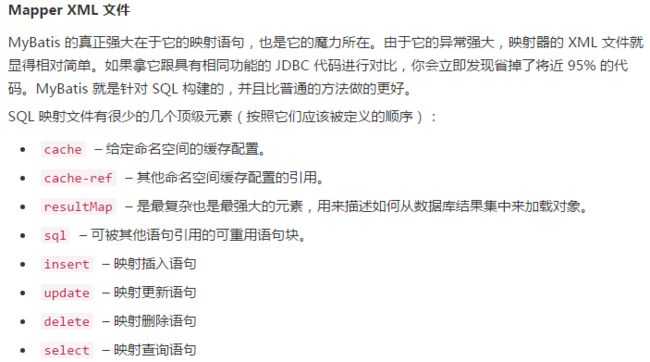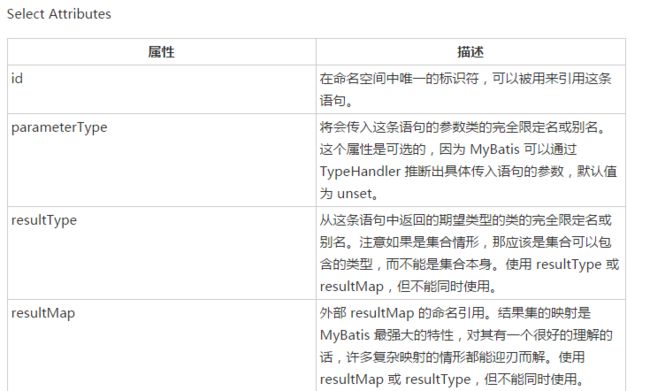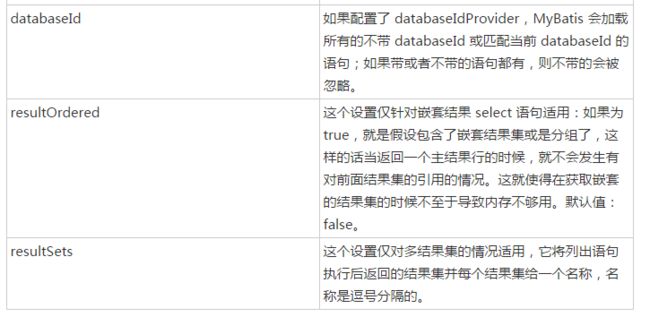在上篇文章中分析了mybatis解析
一、概述
在上篇文章中分析了
下面看部分代码,
if (resource != null && url == null && mapperClass == null) { ErrorContext.instance().resource(resource); InputStream inputStream = Resources.getResourceAsStream(resource); XMLMapperBuilder mapperParser = new XMLMapperBuilder(inputStream, configuration, resource, configuration.getSqlFragments()); /** * 处理mapper文件和对应的接口 */ mapperParser.parse(); }
可以看到调用了XMLMapperBuilder的parse方法,
public void parse() { if (!configuration.isResourceLoaded(resource)) { //1、解析mapper文件中的标签及其子标签,并设置CurrentNamespace的值,供下面第2步使用 configurationElement(parser.evalNode("/mapper")); configuration.addLoadedResource(resource); //2、绑定Mapper接口,并解析对应的XML映射文件 bindMapperForNamespace(); } parsePendingResultMaps(); parsePendingCacheRefs(); parsePendingStatements(); }
从上面的代码中可以看出首先解析resource资源说代表的XML映射文件,然后解析XML;映射文件中的namespace配置的接口。
二、详述
通过上面的分析知道,解析resource配置的XML映射文件,分为两步,第一步就是解析XML映射文件的内容;第二步是解析XML映射文件中配置的namespace属性,也就是对于的Mapper接口。
1、解析XML映射文件
看如何解析XML映射文件内容,也就是下面的这行代码,
configurationElement(parser.evalNode("/mapper"));
看具体的实现,
/** * 解析XML映射文件的内容 * @param context */ private void configurationElement(XNode context) { try { //获得namespace属性 String namespace = context.getStringAttribute("namespace"); if (namespace == null || namespace.equals("")) { throw new BuilderException("Mapper's namespace cannot be empty"); } //设置到currentNamespace中 builderAssistant.setCurrentNamespace(namespace); //解析标签 cacheRefElement(context.evalNode("cache-ref"));
//二级缓存标签 cacheElement(context.evalNode("cache")); parameterMapElement(context.evalNodes("/mapper/parameterMap")); resultMapElements(context.evalNodes("/mapper/resultMap")); sqlElement(context.evalNodes("/mapper/sql")); //解析select、insert、update、delete子标签 buildStatementFromContext(context.evalNodes("select|insert|update|delete")); } catch (Exception e) { throw new BuilderException("Error parsing Mapper XML. The XML location is '" + resource + "'. Cause: " + e, e); } }
上面方法解析XML映射文件的内容,其中有个和二级缓存相关的配置,即
在XML映射文件中可以配置上面的这些标签,也就是上面方法中解析的内容。重点看解析select、update、delete、select。也就是下面这行代码
//解析select、insert、update、delete子标签 buildStatementFromContext(context.evalNodes("select|insert|update|delete"));
其方法定义如下,
private void buildStatementFromContext(Listlist) { if (configuration.getDatabaseId() != null) { buildStatementFromContext(list, configuration.getDatabaseId()); } buildStatementFromContext(list, null); }
这里会校验databaseId,如果自定义配置了,则使用自定义的,否则使用默认的,看方法buildStatementFromContext方法
private void buildStatementFromContext(Listlist, String requiredDatabaseId) { for (XNode context : list) { final XMLStatementBuilder statementParser = new XMLStatementBuilder(configuration, builderAssistant, context, requiredDatabaseId); try { statementParser.parseStatementNode(); } catch (IncompleteElementException e) { configuration.addIncompleteStatement(statementParser); } } }
调用XMLStatementBuilder的parseStatementNode方法
/** * 解析select、update、delete、insert标签 */ public void parseStatementNode() { String id = context.getStringAttribute("id"); String databaseId = context.getStringAttribute("databaseId"); if (!databaseIdMatchesCurrent(id, databaseId, this.requiredDatabaseId)) { return; } Integer fetchSize = context.getIntAttribute("fetchSize"); Integer timeout = context.getIntAttribute("timeout"); String parameterMap = context.getStringAttribute("parameterMap"); String parameterType = context.getStringAttribute("parameterType"); Class parameterTypeClass = resolveClass(parameterType); String resultMap = context.getStringAttribute("resultMap"); String resultType = context.getStringAttribute("resultType"); String lang = context.getStringAttribute("lang"); LanguageDriver langDriver = getLanguageDriver(lang); Class resultTypeClass = resolveClass(resultType); String resultSetType = context.getStringAttribute("resultSetType"); StatementType statementType = StatementType.valueOf(context.getStringAttribute("statementType", StatementType.PREPARED.toString())); ResultSetType resultSetTypeEnum = resolveResultSetType(resultSetType); String nodeName = context.getNode().getNodeName(); SqlCommandType sqlCommandType = SqlCommandType.valueOf(nodeName.toUpperCase(Locale.ENGLISH)); boolean isSelect = sqlCommandType == SqlCommandType.SELECT; boolean flushCache = context.getBooleanAttribute("flushCache", !isSelect); //查询语句默认开启一级缓存,这里默认是true boolean useCache = context.getBooleanAttribute("useCache", isSelect); boolean resultOrdered = context.getBooleanAttribute("resultOrdered", false); // Include Fragments before parsing XMLIncludeTransformer includeParser = new XMLIncludeTransformer(configuration, builderAssistant); includeParser.applyIncludes(context.getNode()); // Parse selectKey after includes and remove them. processSelectKeyNodes(id, parameterTypeClass, langDriver); // Parse the SQL (pre:and //生成SqlSource,这里分两种,DynamicSqlSource和RawSqlSource SqlSource sqlSource = langDriver.createSqlSource(configuration, context, parameterTypeClass); String resultSets = context.getStringAttribute("resultSets"); String keyProperty = context.getStringAttribute("keyProperty"); String keyColumn = context.getStringAttribute("keyColumn"); KeyGenerator keyGenerator; //例,id="selectUser" //这里的keyStatementId=selectUser!selectKey String keyStatementId = id + SelectKeyGenerator.SELECT_KEY_SUFFIX; //keyStatementId=cn.com.dao.userMapper.selectUser!selectKey keyStatementId = builderAssistant.applyCurrentNamespace(keyStatementId, true); if (configuration.hasKeyGenerator(keyStatementId)) { keyGenerator = configuration.getKeyGenerator(keyStatementId); } else { keyGenerator = context.getBooleanAttribute("useGeneratedKeys", configuration.isUseGeneratedKeys() && SqlCommandType.INSERT.equals(sqlCommandType)) ? Jdbc3KeyGenerator.INSTANCE : NoKeyGenerator.INSTANCE; } builderAssistant.addMappedStatement(id, sqlSource, statementType, sqlCommandType, fetchSize, timeout, parameterMap, parameterTypeClass, resultMap, resultTypeClass, resultSetTypeEnum, flushCache, useCache, resultOrdered, keyGenerator, keyProperty, keyColumn, databaseId, langDriver, resultSets); }were parsed and removed)
上面的代码主要是解析标签中的各种属性,那么标签中可以配置哪些属性那,下面看select标签的属性,详情可参见https://www.w3cschool.cn/mybatis/f4uw1ilx.html
上面是select标签中可以配置的属性列表。
上面的代码重点看以下重点
二级缓存
下面看和缓存相关的
boolean isSelect = sqlCommandType == SqlCommandType.SELECT; boolean flushCache = context.getBooleanAttribute("flushCache", !isSelect); //查询语句默认开启一级缓存,这里默认是true boolean useCache = context.getBooleanAttribute("useCache", isSelect);
这里仅针对select查询语句使用缓存,这里的默认不会刷新缓存flushCache为false,默认开启缓存useCache为ture,这里的缓存指的是一级缓存,经常说的mybatis一级缓存,一级缓存是sqlSession级别的。
看完了一级缓存,下面看SqlSource的内容
SqlSource
下面是SqlSource相关的,
//生成SqlSource,这里分两种,DynamicSqlSource和RawSqlSource SqlSource sqlSource = langDriver.createSqlSource(configuration, context, parameterTypeClass);
上面是生成SqlSource的过程,
@Override public SqlSource createSqlSource(Configuration configuration, XNode script, Class parameterType) { XMLScriptBuilder builder = new XMLScriptBuilder(configuration, script, parameterType); return builder.parseScriptNode(); }
看parseScriptNode方法
public SqlSource parseScriptNode() { MixedSqlNode rootSqlNode = parseDynamicTags(context); SqlSource sqlSource = null; if (isDynamic) { //含义${}符合的为DynamicSqlSource sqlSource = new DynamicSqlSource(configuration, rootSqlNode); } else { //不含有${}的为rawSqlSource sqlSource = new RawSqlSource(configuration, rootSqlNode, parameterType); } return sqlSource; }
从上面的代码可以看到在映射文件中根据参数占位符的标识符(${}、#{})分为DynamicSqlSource和RawSqlSource。具体如何判断,后面详细分析。
addMappedStatement
最后看builderAssistant.addMappedStatement方法,
public MappedStatement addMappedStatement( String id, SqlSource sqlSource, StatementType statementType, SqlCommandType sqlCommandType, Integer fetchSize, Integer timeout, String parameterMap, Class parameterType, String resultMap, Class resultType, ResultSetType resultSetType, boolean flushCache, boolean useCache, boolean resultOrdered, KeyGenerator keyGenerator, String keyProperty, String keyColumn, String databaseId, LanguageDriver lang, String resultSets) { if (unresolvedCacheRef) { throw new IncompleteElementException("Cache-ref not yet resolved"); } //cn.com.dao.UserMapper.selectUser id = applyCurrentNamespace(id, false); boolean isSelect = sqlCommandType == SqlCommandType.SELECT; MappedStatement.Builder statementBuilder = new MappedStatement.Builder(configuration, id, sqlSource, sqlCommandType) .resource(resource) .fetchSize(fetchSize) .timeout(timeout) .statementType(statementType) .keyGenerator(keyGenerator) .keyProperty(keyProperty) .keyColumn(keyColumn) .databaseId(databaseId) .lang(lang) .resultOrdered(resultOrdered) .resultSets(resultSets) .resultMaps(getStatementResultMaps(resultMap, resultType, id)) .resultSetType(resultSetType) .flushCacheRequired(valueOrDefault(flushCache, !isSelect)) .useCache(valueOrDefault(useCache, isSelect)) .cache(currentCache); ParameterMap statementParameterMap = getStatementParameterMap(parameterMap, parameterType, id); if (statementParameterMap != null) { statementBuilder.parameterMap(statementParameterMap); } MappedStatement statement = statementBuilder.build(); /*向mappedStatements字段中加入MappedStatement,这里会加入两个key * cn.com.dao.UserMapper.selectUser statement * selectUser statement * 每次都会插入上面的两种key,两种key对应的value都是同一个statement * */ configuration.addMappedStatement(statement); return statement; }
该方法主要完成的功能是生成MappedStatement,且放入configuration中。
2、解析namespace属性
上面分析了解析XML映射文件的内容的过程,最后的结果是把XML映射文件中的select、update、insert、delete标签的内容解析为MappedStatement。下面看解析XML映射文件中的namespace属性,
//2、绑定Mapper接口,并解析对应的XML映射文件 bindMapperForNamespace();
上面我给的注释是绑定接口并解析对应的XML映射文件,这个方法没有参数,怎么绑定具体的接口并解析对应的映射文件那,
private void bindMapperForNamespace() { String namespace = builderAssistant.getCurrentNamespace(); if (namespace != null) { Class boundType = null; try { //加载类,这里加载的是mapper文件中配置的namespace配置的接口 boundType = Resources.classForName(namespace); } catch (ClassNotFoundException e) { //ignore, bound type is not required } if (boundType != null) { if (!configuration.hasMapper(boundType)) {//判断该接口是否被加载过,在mapperRegistry中的knowsMapper中判断 // Spring may not know the real resource name so we set a flag // to prevent loading again this resource from the mapper interface // look at MapperAnnotationBuilder#loadXmlResource //把该接口作为已加载的资源存放到loadedResources中,loadedResources存放的是已加载的mapper文件的路径 configuration.addLoadedResource("namespace:" + namespace); //把该接口放到mapperRegistry中的knowsMapper中,并解析该接口,根据loadedResources判定是否需要解析相应的XML映射文件 configuration.addMapper(boundType); } } } }
获得builderAssistant.getCurrentNamespace(),在解析XML映射文件时,第一步便是设置该属性,这里用到的便是上一步中设置的那个XML映射文件中的namespace属性值。获得该接口的名称,判断是否生成过MapperProxyFactory,即放入过knownMappers中,看configuration.hasMapper方法,
public boolean hasMapper(Class type) { return mapperRegistry.hasMapper(type); }
publicboolean hasMapper(Class type) { return knownMappers.containsKey(type); }
如果在knownMappers中,则不进行解析,如果不在才进行下面的逻辑处理,调用configuration.addLoadedResource方法,放入loadedResources中,标识在第一步已经解析过对应的XML映射文件;调用configuration.addMapper方法,解析该接口,这个过程和在
三、总结
本文分析了mappers标签中mapper子标签中resource和url属性的解析过程,首先解析对应的XML映射文件,解析的结果为MappedStatement对象,然后解析其namespace对应的接口,解析的结果为MapperProxyFactory对象。
有不当之处,欢迎指正,感谢!



